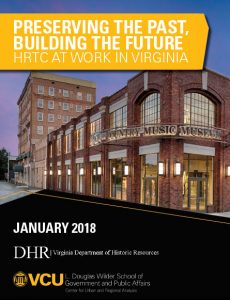 Virginia Department of Historic Resources
Virginia Department of Historic Resources Virginia Department of Historic Resources
Virginia Department of Historic ResourcesPlease note these recent announcements:
NOTE: Tax credit staff are available for virtual or in-person meetings for all applicants upon request as follows:
The preservation of historic buildings benefits communities and connects us to our heritage, enriching the quality of our lives in many tangible and intangible ways. Their preservation also provides demonstrable economic benefits.
Through the federal and state rehabilitation tax credit programs, property owners are given substantial incentives for private investment in preservation, resulting in enormous advantages to the public.
Both the federal and state tax credit programs are administered in Virginia through the Department of Historic Resources.
State tax credits are available for owner-occupied, as well as income-producing buildings. If your property is income-producing, you may also be able to take advantage of federal tax credits. Additional information and assistance with tax-credit projects may be requested from DHR’s Richmond office. Contact Chris Novelli at (804) 482-6097.

Virginia’s Historic Rehabilitation Tax Credit (HRTC) program has played an essential role in the preservation of thousands of historic properties since its inception in 1997. Between 1997 and 2017, the program issued $1.2 billion in tax credits, reimbursing 25 percent of eligible rehabilitation expenses as tax credits. Those tax credits have stimulated $4.5 billion in private investment since 1997. Although the $1.2 billion in tax credits issued represents revenue not immediately realized by the Commonwealth, much of the $4.5 billion of private investment may not have otherwise occurred, according to a 2018 economic impact study by VCU’s L. Douglas Wilder School of Government and Public Affairs. The VCU study analyzes the Historic Rehabilitation Tax Credit program to better understand its costs and benefits to Virginia, its communities, and its historic buildings. The study shows that Virginia’s return in investment, represented by tax credits, is repaid in five to nine years. Here’s the full 94-page report. No time for that? Read the Executive Summary (4 pgs) or this Illustrated Summary.
Also of note, in 2017 Preservation Virginia, in partnership with the Home Builders Association, undertook a deep-dive study into the economic benefits of the historic rehabilitation tax credit program in Virginia. Baker Tilly Virchow Krause, LLP (Baker Tilly), a nationally recognized, full-service accounting and advisory firm, studied the economic impact of 21 projects completed in 2014. Their findings demonstrate the Historic Rehabilitation Tax Credit Program doesn’t just preserve the places that make Virginia unique. In 2014 alone it resulted in:
The study can be found here on the Preservation Virginia website.
Updated February 6, 2023